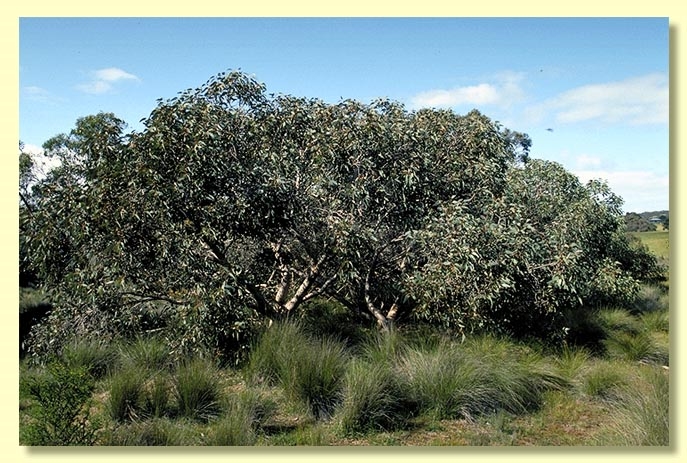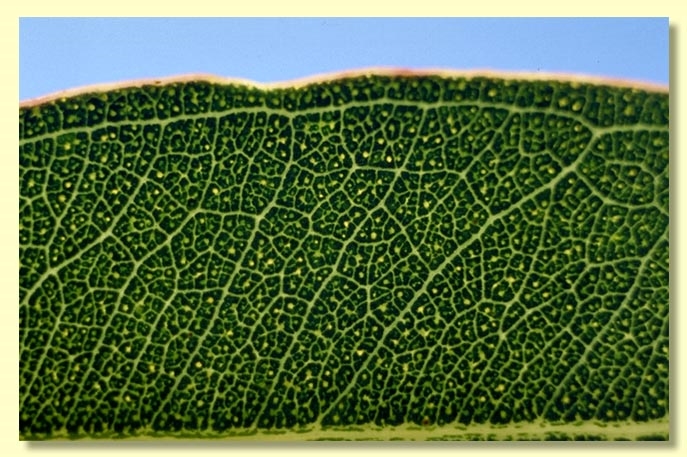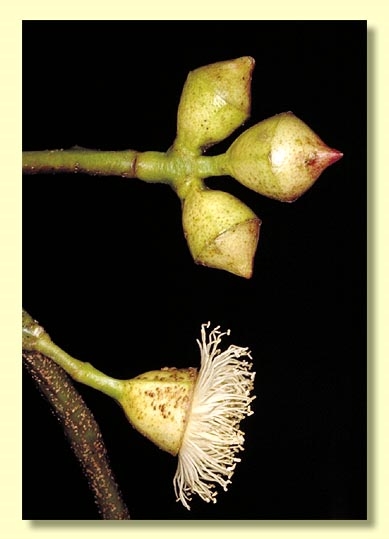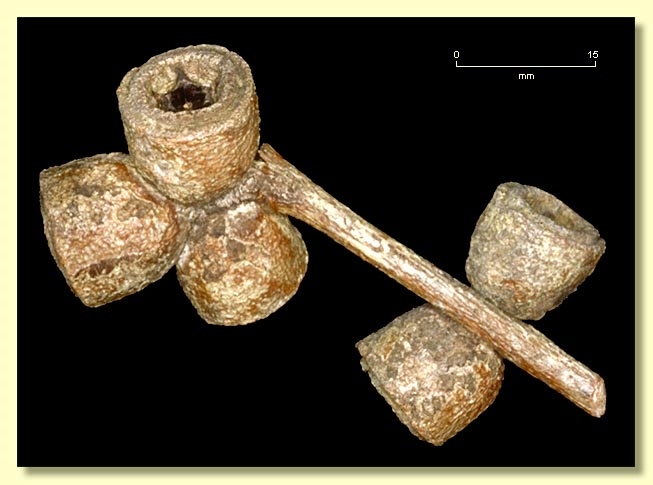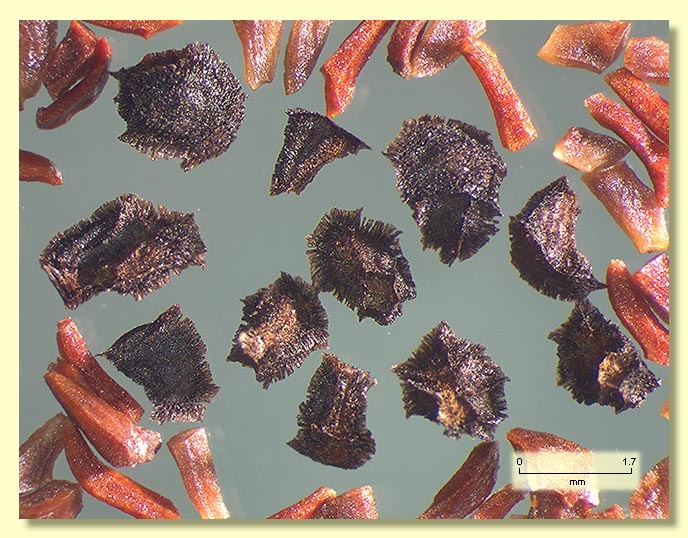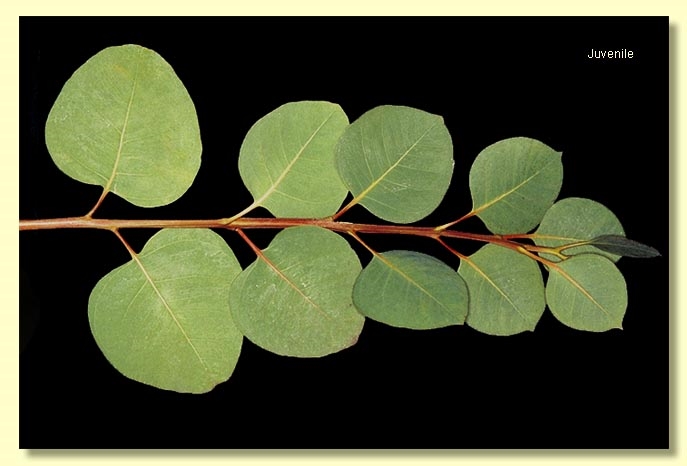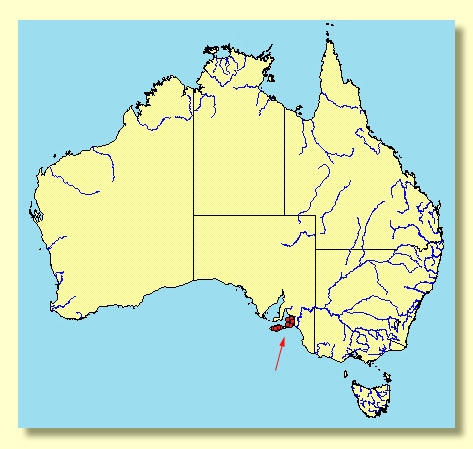Euclid - Online edition
Eucalyptus cosmophylla
Eucalyptus | Symphyomyrtus | Incognitae
T: Lofty Ranges, S.A., 2 Mar. 1848 & Nov. 1848, F.Mueller s.n.; syn: MEL; Bugle Ranges, S.A., 28 Apr. 1848 & July 1851, F.Mueller s.n.; syn: MEL.
Eucalyptus cosmophylla f. leprosula F.Muell. ex Miq., Ned. Kruidk. Arch. 4: 134 (1856); E. cosmophylla var. leprosula (F.Muell. ex Miq.) F.Muell. ex Maiden, Crit. Revis. Eucalyptus 3: 17 (1917). T: none cited.
Eucalyptus cosmophylla var. rostrigera F.Muell. ex Maiden, Crit. Revis. Eucalyptus 3: 17 (1917). T: Mt Barker Ra., S.A., F.Mueller s.n.; holo: MEL.
Bark smooth throughout or with a few loose basal grey or brown rough slabs; smooth bark becoming granular with age, white to cream, grey, blue-grey or yellow.
Juvenile growth (coppice or field seedlings to 50 cm): stems square and slightly winged; juvenile leaves always petiolate, opposite until node 4 or 5, then alternate, deltoid to broadly ovate, 4–9 cm long, 4.5–9.5 cm wide, base truncate to tapering or sometimes oblique, apex emarginate, rounded or apiculate, concolorous, dull, green.
Adult leaves alternate, petiole 1.5–4 cm long; blade lanceolate to broadly lanceolate, 8–18 cm long, 1.3–5 cm wide, base tapering to petiole, or oblique (sometimes), concolorous, slightly glossy to dull, light green to grey-green, side-veins greater than 45° to midrib, moderately to densely reticulate, intramarginal vein well removed from margin, oil glands island, intersectional or obscure.
Inflorescence axillary unbranched, peduncles 0.1–1.3 cm long (often very short); buds 3 per umbel, sessile or shortly pedicellate (pedicels 0–0.6 cm long). Mature buds ovoid to pyriform (1.1–2.2 cm long, 0.7–1.5 cm wide), green to yellow, scar present, operculum conical to rounded to beaked, stamens inflexed, anthers cuboid to oblong, versatile, dorsifixed, dehiscing by longitudinal slits (non-confluent), style long, stigma blunt, locules 4 or 5, the placentae each with 8 or 10 vertical ovule rows. Flowers white.
Fruit sessile to shortly pedicellate (pedicels 0–0.7 cm long), cup-shaped to cylindrical, 0.9–1.8 cm long, 1–2.2 cm wide, often slightly 2-ribbed longitudinally, disc descending, valves 4 or 5, near rim level.
Seeds black, 1–3 mm long, pyramidal or obliquely pyramidal with ragged, almost winged, edges, dorsal surface smooth or slightly wrinkled, not winged, hilum terminal.
Cultivated seedlings (measured at ca node 10): cotyledons bilobed to oblong; stems square or rounded in cross-section; leaves always petiolate, opposite for 3 to 5 nodes then alternate, ovate to deltoid or orbicular, 4.3–8.5 cm long, 4–9.5 cm wide, base truncate to tapering, margin entire or subcrenulate, apex rounded, emarginate or apiculate, dull, grey-green to green.
Flowering has been recorded in March, April, May, July, September, October and November.
A small, mostly smooth-barked tree or mallee of Kangaroo Island and the Mt Lofty Range in South Australia. E. cosmophylla is easily recognised by the three-budded inflorescences and the large, sessile or shortly pedicellate buds and fruits. Associated three-budded species are E. leucoxylon, which differs by the slender pedicels and lack of an operculum scar, and the much taller E. viminalis and E. dalrympleana, which differ by the smaller buds and fruit and the numerous pairs of opposite, juvenile leaves (alternate after four or five nodes in E. cosmophylla). E. paludicola has pendulous buds in threes and sevens and fruit to 1.5 cm wide. The smooth-barked woodland tree E. fasciculosa, has smaller buds and fruit in terminal panicles.
Eucalyptus cosmophylla is one of two species in Eucalyptus subgenus Symphyomyrtus section Incognitae having cotyledons bilobed, leaves concolorous with intersectional or obscure oil glands, erect inflorescences with buds in threes, buds with two opercula, inflexed stamens and ovules usually in eight or 10 rows, and fruit with valves not enclosed. E. paludicola is closely related to E. cosmophylla and differs as outlined above.

